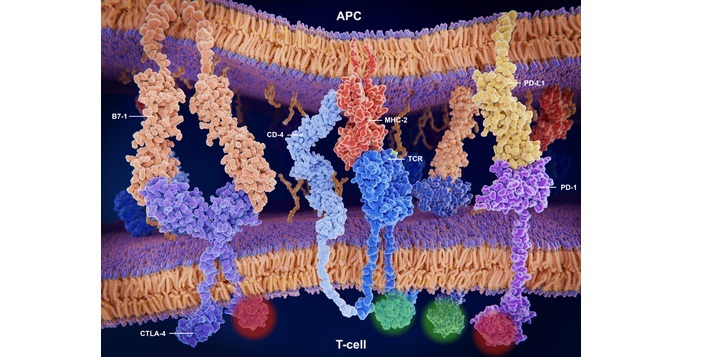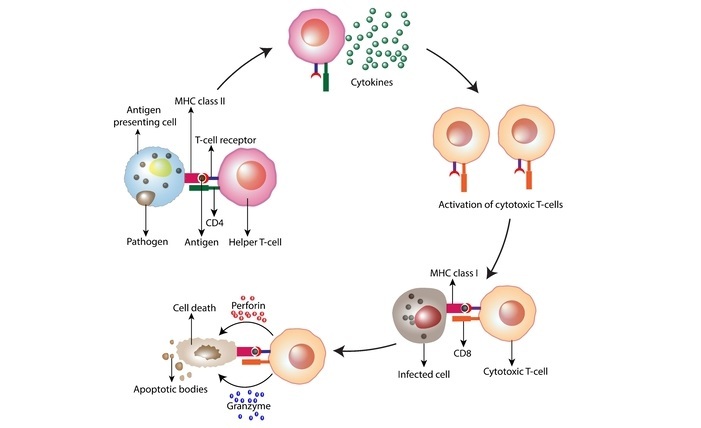
 Data Structure
Data Structure Networking
Networking RDBMS
RDBMS Operating System
Operating System Java
Java MS Excel
MS Excel iOS
iOS HTML
HTML CSS
CSS Android
Android Python
Python C Programming
C Programming C++
C++ C#
C# MongoDB
MongoDB MySQL
MySQL Javascript
Javascript PHP
PHP
- Selected Reading
- UPSC IAS Exams Notes
- Developer's Best Practices
- Questions and Answers
- Effective Resume Writing
- HR Interview Questions
- Computer Glossary
- Who is Who
Synthesis of MHC class I molecules Their types and functions
Introduction
The immune system is responsible for protecting the body against pathogens such as viruses and bacteria. It consists of various cells and molecules that work together to identify and eliminate foreign invaders. One of the key players in this process is the Major Histocompatibility Complex (MHC) class I molecule. Below we shall investigate synthesis of MHC class I molecules, their types, and functions.

Synthesis of MHC Class I Molecules
MHC class I molecules are synthesized in the endoplasmic reticulum (ER) of cells. The process of MHC class I synthesis begins with the transcription of the MHC class I gene, which is located on chromosome 6 in humans.
The gene is transcribed into a primary RNA transcript that is then spliced to remove introns and form a mature mRNA molecule. The mRNA molecule is then transported from the nucleus to the cytoplasm, where it is translated into a polypeptide chain.
The nascent polypeptide chain is then transported into the ER lumen by the translocon complex, which spans the ER membrane. In the ER lumen, the polypeptide chain undergoes a series of post-translational modifications that are critical for the proper folding and assembly of the MHC class I molecule.
These modifications include the addition of N-linked glycans, disulfide bond formation, and the association of the MHC class I heavy chain with a ?2-microglobulin (?2m) molecule.
Types of MHC Class I Molecules
The Major Histocompatibility Complex (MHC) class I molecules play a critical role in the immune system by presenting intracellular peptides to CD8+ T cells. There are three main types of MHC class I molecules in humans, which are encoded by different genes on chromosome 6: HLA-A, HLA-B, and HLA-C.
Each of these molecules has unique features, including their peptide-binding specificities, which enable them to present a diverse range of intracellular peptides to CD8+ T cells. In this section, we will discuss the types of MHC class I molecules in more detail.
HLA-A
HLA-A is the most polymorphic of the three MHC class I genes, with over 1,000 known alleles. It is expressed on almost all nucleated cells in the body and is involved in the presentation of intracellular peptides to CD8+ T cells.
HLA-A molecules have a peptide-binding groove that can accommodate peptides that are 8-10 amino acids in length. The amino acid residues at positions 2 and 9 of the peptide are critical for binding to the HLA-A molecule.
HLA-B
HLA-B is the second most polymorphic of the three MHC class I genes, with over 800 known alleles. It is expressed on a wide range of cell types and is involved in the presentation of intracellular peptides to CD8+ T cells.
HLA-B molecules have a peptide-binding groove that can accommodate peptides that are 8-11 amino acids in length. The amino acid residues at positions 2, 3, 7, and 9 of the peptide are critical for binding to the HLA-B molecule.
HLA-C
HLA-C is the least polymorphic of the three MHC class I genes, with only about 200 known alleles.
It is expressed on a limited range of cell types, including some immune cells, and is involved in the presentation of intracellular peptides to CD8+ T cells. HLA-C molecules have a peptide-binding groove that can accommodate peptides that are 8-10 amino acids in length.
The amino acid residues at positions 2 and 9 of the peptide are critical for binding to the HLA-C molecule.
In addition to their unique peptide-binding specificities, the three types of MHC class I molecules also differ in their tissue distribution, expression levels, and functional properties.
For example, HLA-A and HLA-B are expressed on a wider range of cell types than HLA-C and are more efficient at presenting viral peptides to CD8+ T cells.

Functions of MHC Class I Molecules
Antigen Presentation
The primary function of MHC class I molecules is to present intracellular peptides to CD8+ T cells. This presentation of peptides occurs when intracellular proteins are degraded into peptides by the proteasome and then transported into the endoplasmic reticulum (ER) by the transporter associated with antigen processing (TAP) molecules.
In the ER, the peptides bind to the MHC class I molecules, which are then transported to the cell surface where they are presented to CD8+ T cells.
Immune Surveillance
MHC class I molecules are critical for immune surveillance, which is the process by which the immune system monitors the body for signs of infection, cancer, and other abnormalities.
The CD8+ T cells recognize and destroy cells that present foreign peptides on their MHC class I molecules, thereby eliminating infected cells and preventing the development of cancer.
Immune Evasion
Some pathogens, such as viruses, have developed mechanisms to evade the immune system by interfering with the expression or function of MHC class I molecules.
For example, some viruses can downregulate the expression of MHC class I molecules on infected cells, thereby reducing the ability of CD8+ T cells to recognize and destroy these cells.
Similarly, some viruses can produce proteins that interfere with the function of the MHC class I molecules, thereby preventing the presentation of viral peptides to CD8+ T cells.
Transplant Rejection
MHC class I molecules are also important for transplant rejection, which is the process by which the immune system recognizes and attacks transplanted tissues that are not genetically identical to the recipient.
The CD8+ T cells recognize foreign MHC class I molecules on the transplanted tissues and initiate an immune response that can lead to the rejection of the transplant.
Autoimmunity
Abnormalities in MHC class I molecules have been associated with the development of autoimmune diseases, such as Type 1 diabetes and rheumatoid arthritis.
In these diseases, the immune system mistakenly attacks the body's own tissues, which are recognized as foreign due to abnormalities in the MHC class I molecules.

